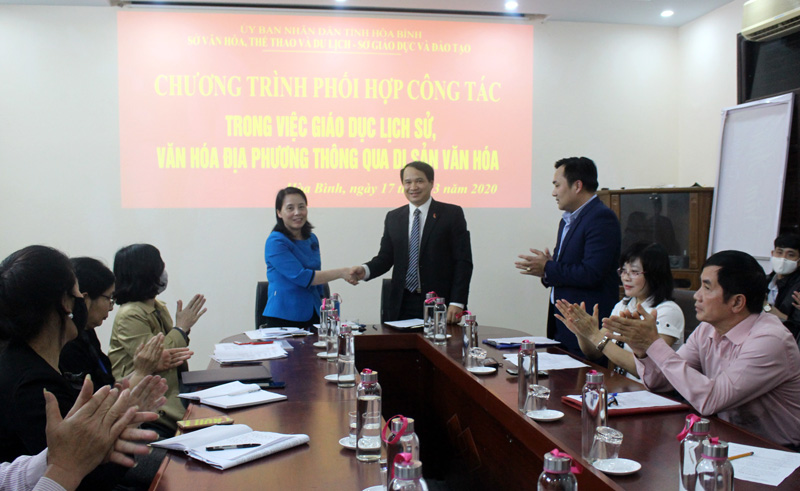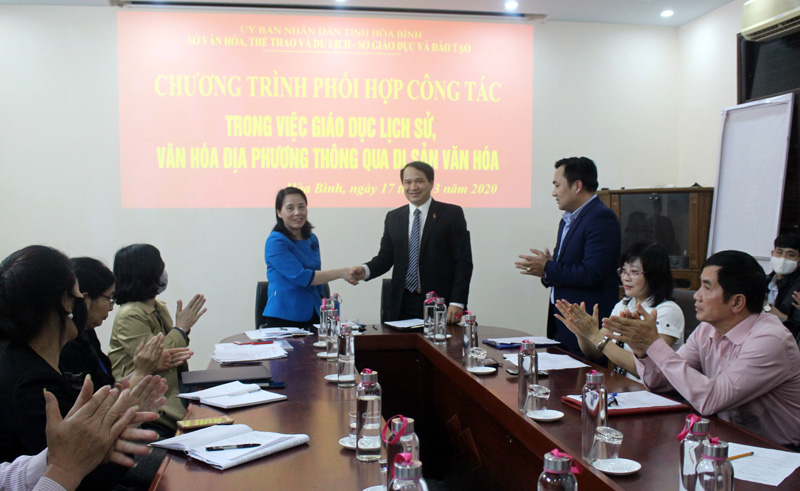
(HBO) – Hoa Binh’s Department of Culture, Sports and Tourism and Department of Education and Training on March 17 signed a joint cooperation programme on educating people about local history and traditional culture through cultural heritages.
 Leaders of Hoa Binh’s Department
of Culture, Sports and Tourism and Department of Education and Training sign a
joint cooperation programme on March 17.
Leaders of Hoa Binh’s Department
of Culture, Sports and Tourism and Department of Education and Training sign a
joint cooperation programme on March 17.
The agreement is part of
activities to implement the Ministry of Culture, Sport and Tourism’s project on
improving quality and effectiveness of museum operation in tandem with
developing tourism.
It is expected to
facilitate a closer coordination between the two provincial departments in
enhancing the capacity and effectiveness of their work to educate people on the
province’s history and traditional culture through local cultural heritages.
They will also work
together to provide students with lessons on history and culture at museums and
promote the preservation of historical and cultural values.
The students will be
offered real-world experience to discover local history and cultural, thus
raising their sense of responsibility to protect the historical and cultural
heritages and inspiring their patriotism.
Under the deal, the two
departments will together develop and compile materials and documents
introducing Hoa Binh’s cultural heritages to the students and design field
trips to the museums for the students of different ages.
They will also organise clubs
and classes to teach students about local intangible cultural heritages, such
as folk games and folk singing./.
The People’s Committee of Lac Son district held a ceremony on April 28 to receive the provincial relic certificate for the ancient rock carving site at Suoi Co stream, located in My Thanh commune.
A special music show titled "The country is in the fullness of joy” has been held at Hoa Binh Square in Hoa Binh city in celebration of the 50th anniversary of the liberation of the South and national reunification (April 30, 1975–2025).
The People's Committee of Lo Son commune, Tan Lac district, has organised the local annual traditional stream fishing festival on April 19 - 20.
As a land deeply intertwined with human history and Vietnam’s millennia-long journey of nation-building and defence, Hoa Binh is often revered for its epic tales and legends.
Residents of Hoa Binh boast a rich cultural identity, reflected in their unique language, traditional attire, customs, and folk melodies – described as "sweet as honey, clear as a mountain stream.”
Lac Son district’s Vu ban town held the 2025 Truong Kha temple festival on April 12–13 (the 15th–16th days of the third lunar month). Since its revival in 2019, the festival has been organised every three years, preserving valuable intangible heritage while meeting the community’s cultural and spiritual needs.



 Leaders of Hoa Binh’s Department
of Culture, Sports and Tourism and Department of Education and Training sign a
joint cooperation programme on March 17.
Leaders of Hoa Binh’s Department
of Culture, Sports and Tourism and Department of Education and Training sign a
joint cooperation programme on March 17.